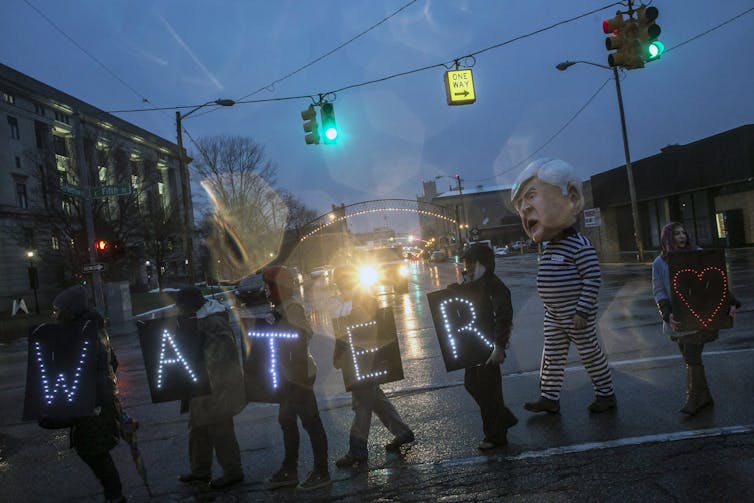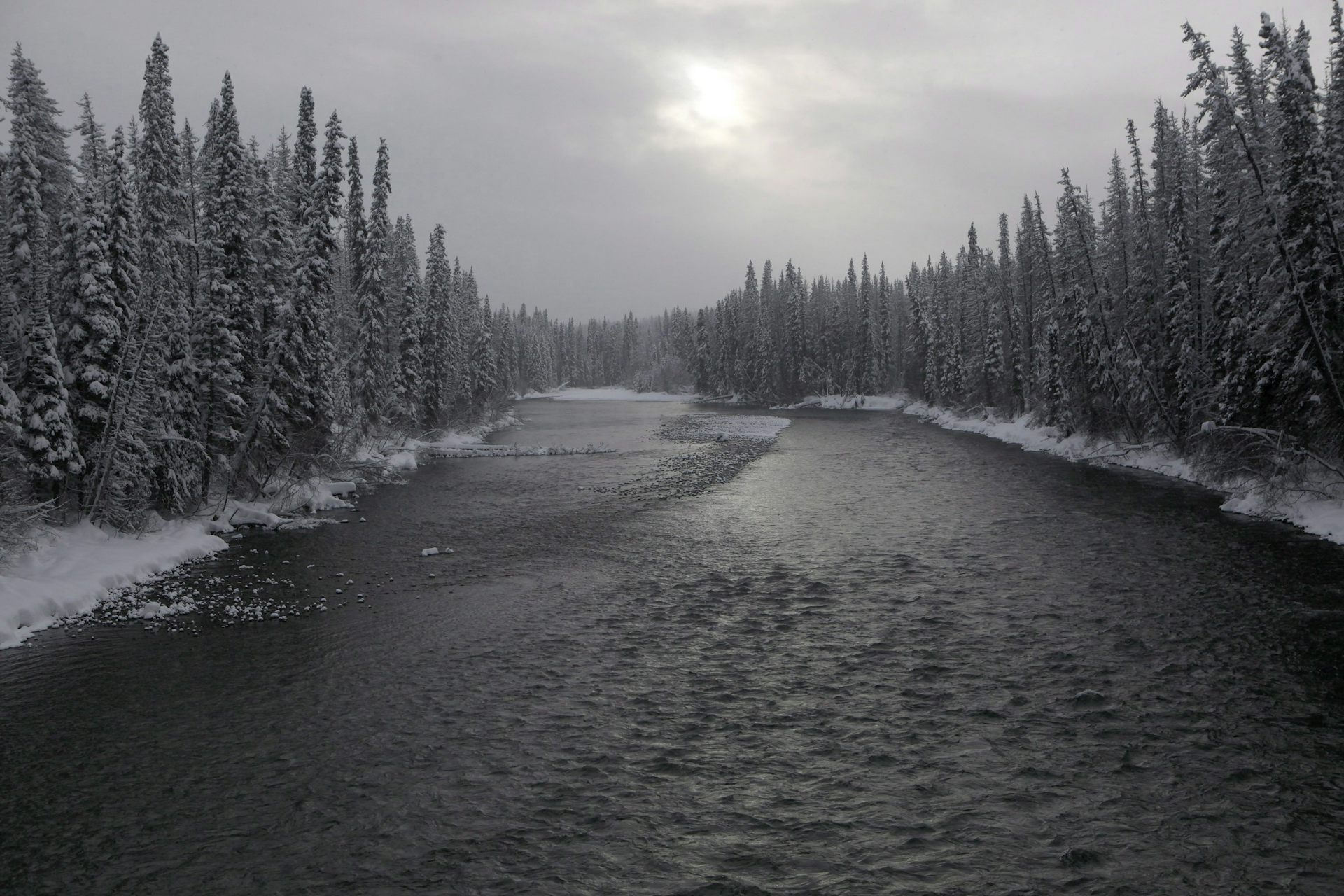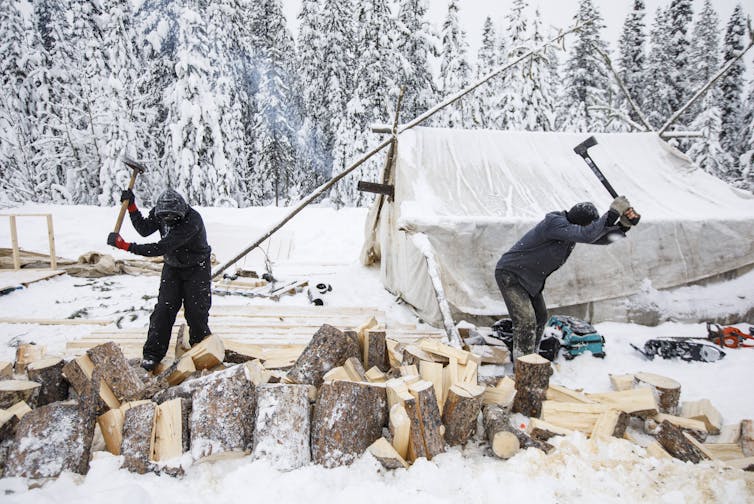After a decade out in the cold, 2020 is shaping up to be the year of the pipeline
Legal wins and investor interest breathing new life into projects that have been on hold for years
AFTER ALL THAT WHINING BIG OIL HITS IT BIG AGAIN

Demonstrators rally in 2018 in favour of the Trans Mountain pipeline expansion outside the Alberta Legislature, in Edmonton.David Bloom/Postmedia
February 10, 2020
CALGARY – A year ago, Enbridge Inc.’s $9-billion Line 3 and TC Energy Corp.’s US$8-billion Keystone XL pipeline projects, as well as, of course, the $12.6-bilion Trans Mountain expansion had been mired in regulatory or legal delays for so long that there were questions about whether they would ever be built.
Indeed, the past decade was largely one to forget for Canadian pipeline companies trying to build major new export projects.
February 10, 2020
CALGARY – A year ago, Enbridge Inc.’s $9-billion Line 3 and TC Energy Corp.’s US$8-billion Keystone XL pipeline projects, as well as, of course, the $12.6-bilion Trans Mountain expansion had been mired in regulatory or legal delays for so long that there were questions about whether they would ever be built.
Indeed, the past decade was largely one to forget for Canadian pipeline companies trying to build major new export projects.

Pro-pipeline supporter demonstrates on Parliament Hill in Ottawa as part of a convoy from Alberta in 2019. Errol McGihon/Postmedia
All the delays, Saskatchewan Premier Scott Moe told an audience at the Canada Institute in Washington on Friday, resulted in negative economic impacts that extend beyond the energy sector.
For instance, about 10 per cent of Saskatchewan’s energy products are currently moving on rail cars, he said, which creates challenges for other sectors looking to move their products.
“We’re cramping our rail capacity, capacity that we actually need if we’re going to continue producing things that should be on rail, like our agrifood products, like our timber products,” Moe said, speaking alongside Alberta Premier Jason Kenney.
But there are signs that the pipeline industry is finally turning around. Major court wins in the first six weeks of 2020 have cleared the way for construction to begin on the Line 3 and Keystone XL pipelines in the U.S. and to continue on Trans Mountain.
What a difference a new decade makes. We’re kind of into a new world
Canadian Energy Pipelines Association chief executive Chris Bloomer
“What a difference a new decade makes,” said Canadian Energy Pipelines Association chief executive Chris Bloomer, referring to a massive change in sentiment in the Canadian oil and gas pipeline industry following the string of legal wins. “We’re kind of into a new world.”
On Monday, the Minnesota Public Utilities Commission voted to re-approve the Line 3 pipeline across the state, removing the last obstacle there for Enbridge. On Tuesday, the Federal Court of Appeal dismissed the last remaining legal challenge to Trans Mountain. Alberta Energy Minister Sonya Savage speaks to several thousand pro pipeline protesters rallying at Stampede Park during the Global Petroleum Show in Calgary in June, 2019. Gavin Young/Postmedia
Alberta Energy Minister Sonya Savage speaks to several thousand pro pipeline protesters rallying at Stampede Park during the Global Petroleum Show in Calgary in June, 2019. Gavin Young/Postmedia
“We can’t handle any further delays,” Alberta Energy Minister Sonya Savage said of the three major oil pipeline projects.
Savage said Alberta is currently in a “perilous situation” because of the failure in recent years of other pipeline projects, such as Northern Gateway (which she worked on while at Enbridge until 2015) and Energy East. The result was that a glut of oil built up in the province as total oil production surpassed export pipeline capacities.
Indigenous rail blockades over Coastal Gaslink pipeline cause chaos for Ontario travellers
Cost to build Trans Mountain pipeline jumps 70% to $12.6 billion
With its legal hurdles all but cleared, Trans Mountain's challenges move to a different court — the street
Over the past four weeks, following favourable decisions on Keystone XL, Line 3 and Trans Mountain, she said “it feels like the type of day when the clouds are lifting” and is confident the projects will move quickly now.
Others are similarly optimistic.
“We have more certainty about the Trans Mountain project than at any time in the past,” Trans Mountain Corp. chief executive Ian Anderson said during a news conference on Friday. “There isn’t anyone who could have pictured the journey we’ve been on the for the last number of years.”
It wasn’t all good news. The updated cost estimate for building the 590,000-barrels-per-day pipeline expansion to the West Coast have jumped 73 per cent to $12.6 billion from $7.3 billion in 2018. Trans Mountain construction underway in Alberta. Trans Mountain
Trans Mountain construction underway in Alberta. Trans Mountain
About half of those higher costs, Anderson said, resulted from changes such as having more thick-walled pipeline sections after the federal government bought the pipeline system from Houston-based Kinder Morgan Inc. in 2018 for $4.5 billion.
Other additional costs were because of market changes. At the time construction first started on Trans Mountain in 2018, Anderson said there weren’t any other pipelines being built.
But since construction was delayed by a Federal Court of Appeal ruling, TC Energy is in the process of building the $6.6-billion Coastal GasLink project through northern British Columbia and gearing up to build Keystone XL, while Enbridge is also readying to build the U.S. portion of Line 3.
One result of the improved outlook for both oil and natural gas pipelines is that analysts believe generalist investors might be interested in jumping back into Canadian oil and gas stocks. Investors have generally shied away from the industry, but some strategic countercyclical investors stayed behind and bought up assets worth billions of dollars.
“There has been an uptick in venture capital and private equity looking at the midstream sector in Canada,” said Alan Ross, regional managing partner at Borden Ladner Gervais LLP in Calgary.
Ross said Canadian pipeline and midstream assets, such as natural gas gathering and processing facilities, have been undervalued in recent years because of regulatory and court delays to major export pipeline projects. Miles of unused pipe, prepared for the proposed Keystone XL pipeline, sit in a lot in 2014 outside Gascoyne, North Dakota. Major court wins in the first six weeks of 2020 have cleared the way for construction to begin on the Line 3 and Keystone XL pipelines in the U.S. and to continue on Trans Mountain. Andrew Burton/Getty Images files
Miles of unused pipe, prepared for the proposed Keystone XL pipeline, sit in a lot in 2014 outside Gascoyne, North Dakota. Major court wins in the first six weeks of 2020 have cleared the way for construction to begin on the Line 3 and Keystone XL pipelines in the U.S. and to continue on Trans Mountain. Andrew Burton/Getty Images files
“Given some of the market access issues, some of the midstream assets have been overlooked over the last number of years,” he said, adding that sentiment has been improving with legal and regulatory wins by major pipeline companies. “A rising tide floats all boats.”
Eight private-equity firms and the private-equity arms of major Canadian pension funds have sponsored new companies such as SemCAMS Midstream ULC, North River Midstream Inc., Steel Reef Corp. and others in countercyclical investments that cut against much of the pessimism in the sector.
In addition to launching new midstream companies, major institutional investors have said they believe Canadian pipeline assets are undervalued and some, like New York-based KKR & Co. Inc. and Alberta Investment Management Corp. (AIMCo), have been buying into pipelines such as the Coastal GasLink project.
AIMCo also bought an 85-per-cent stake in TC Energy’s Northern Courier oilsands pipeline last year for an undisclosed sum.
“One thing that I think a lot of people investing on the private-equity side have picked up on — and some of those are pure private-equity interests and some are more infrastructure investors — is there’s an awareness that there’s a bit of a disconnect between public and private valuations in this space,” said Ben Hawkins, senior vice-president, infrastructure and timber, at AIMCo, which manages $108.2 billion of Alberta’s public-pension assets.
“I do think the current environment is still favourable,” he said, adding that AIMCo is still “keen to look for opportunities.”
Others see value in Canadian midstream assets, too.
For example, Brookfield Infrastructure Partners LP struck one of the largest Canadian energy-sector deals in the past two years when it spent $4.3 billion to buy natural gas infrastructure assets from Enbridge and then launched North River Midstream Inc.
“As we were looking for ways to deploy capital, we turned to Canada because one of the things about the Canadian basin is we actually thought the contractual profile tends to be better (than the U.S.) for a lot of these assets,” said Brian Baker, managing partner at Brookfield Asset Management’s infrastructure group, noting that Canadian midstream assets are usually underpinned by longer contracts than those in the U.S.
He said there have also been more institutional and private-equity investors looking to invest in U.S. midstream infrastructure, raising valuations to the point where his team saw more compelling value in Canada.
“We were trying to look in areas where there’s a little bit less competition (for deals), just given that there’s a lot of negativity around Canada,” Baker said, adding that regulatory overhauls and reviews in Canada have driven away many would-be investors, leading to more enticing valuations for long-term private investors. Supporters hold signs during a United We Roll Convoy For Canada pro-pipeline rally in front of Parliament Hill in Ottawa in 2019. David Kawai/Bloomberg
Supporters hold signs during a United We Roll Convoy For Canada pro-pipeline rally in front of Parliament Hill in Ottawa in 2019. David Kawai/Bloomberg
But analysts are sensing opportunities in the public markets, too.
“We see a potential $20-billion oil pipeline expansion opportunity for the Canadian pipeline industry related to exports to the U.S. and global markets,” BMO Capital Markets analyst Ben Pham said in a research note this week.
He rated Enbridge, TC Energy and Gibson Energy Inc. as outperformers and suggested smart investors would be accumulating shares.
“In the past three years, every single proposed pipeline export project has faced timing delays and created rifts between Western Canadian provinces and Indigenous communities,” Pham said. “But in the next three years, it is possible that several pipelines could actually get built, providing the Western Canadian energy industry more than adequate pipeline capacity to spur additional oilsands development.”
Recent years have been “long, hard, challenging,” CEPA’s Bloomer said, adding that pipeline companies have had to adapt to the challenges presented by the legal and regulatory delays.
“Everybody on all sides of this issue has learned a lot,” he said.
Bloomer said he hopes the Supreme Court of Appeals Court decisions in recent weeks have created some precedence for how pipelines are proposed, permitted and approved in the future.
“From all sides, we’re a lot smarter than we were,” he said.
With files from Naomi Powell
Email: gmorgan@nationalpost.com | Twitter: geoffreymorganRELATED STORIES

UN racism committee calls for halt to Trans Mountain, Coastal GasLink pipelines and Site C dam over treatment of First Nations
While Canada hesitates, Russia builds 3,000 km gas pipeline to China in just five years
Infamous ‘War in the Woods’ in 1990s offers lesson for the Coastal Gaslink pipeline debate
All the delays, Saskatchewan Premier Scott Moe told an audience at the Canada Institute in Washington on Friday, resulted in negative economic impacts that extend beyond the energy sector.
For instance, about 10 per cent of Saskatchewan’s energy products are currently moving on rail cars, he said, which creates challenges for other sectors looking to move their products.
“We’re cramping our rail capacity, capacity that we actually need if we’re going to continue producing things that should be on rail, like our agrifood products, like our timber products,” Moe said, speaking alongside Alberta Premier Jason Kenney.
But there are signs that the pipeline industry is finally turning around. Major court wins in the first six weeks of 2020 have cleared the way for construction to begin on the Line 3 and Keystone XL pipelines in the U.S. and to continue on Trans Mountain.
What a difference a new decade makes. We’re kind of into a new world
Canadian Energy Pipelines Association chief executive Chris Bloomer
“What a difference a new decade makes,” said Canadian Energy Pipelines Association chief executive Chris Bloomer, referring to a massive change in sentiment in the Canadian oil and gas pipeline industry following the string of legal wins. “We’re kind of into a new world.”
On Monday, the Minnesota Public Utilities Commission voted to re-approve the Line 3 pipeline across the state, removing the last obstacle there for Enbridge. On Tuesday, the Federal Court of Appeal dismissed the last remaining legal challenge to Trans Mountain.
 Alberta Energy Minister Sonya Savage speaks to several thousand pro pipeline protesters rallying at Stampede Park during the Global Petroleum Show in Calgary in June, 2019. Gavin Young/Postmedia
Alberta Energy Minister Sonya Savage speaks to several thousand pro pipeline protesters rallying at Stampede Park during the Global Petroleum Show in Calgary in June, 2019. Gavin Young/Postmedia“We can’t handle any further delays,” Alberta Energy Minister Sonya Savage said of the three major oil pipeline projects.
Savage said Alberta is currently in a “perilous situation” because of the failure in recent years of other pipeline projects, such as Northern Gateway (which she worked on while at Enbridge until 2015) and Energy East. The result was that a glut of oil built up in the province as total oil production surpassed export pipeline capacities.
Indigenous rail blockades over Coastal Gaslink pipeline cause chaos for Ontario travellers
Cost to build Trans Mountain pipeline jumps 70% to $12.6 billion
With its legal hurdles all but cleared, Trans Mountain's challenges move to a different court — the street
Over the past four weeks, following favourable decisions on Keystone XL, Line 3 and Trans Mountain, she said “it feels like the type of day when the clouds are lifting” and is confident the projects will move quickly now.
Others are similarly optimistic.
“We have more certainty about the Trans Mountain project than at any time in the past,” Trans Mountain Corp. chief executive Ian Anderson said during a news conference on Friday. “There isn’t anyone who could have pictured the journey we’ve been on the for the last number of years.”
It wasn’t all good news. The updated cost estimate for building the 590,000-barrels-per-day pipeline expansion to the West Coast have jumped 73 per cent to $12.6 billion from $7.3 billion in 2018.
 Trans Mountain construction underway in Alberta. Trans Mountain
Trans Mountain construction underway in Alberta. Trans MountainAbout half of those higher costs, Anderson said, resulted from changes such as having more thick-walled pipeline sections after the federal government bought the pipeline system from Houston-based Kinder Morgan Inc. in 2018 for $4.5 billion.
Other additional costs were because of market changes. At the time construction first started on Trans Mountain in 2018, Anderson said there weren’t any other pipelines being built.
But since construction was delayed by a Federal Court of Appeal ruling, TC Energy is in the process of building the $6.6-billion Coastal GasLink project through northern British Columbia and gearing up to build Keystone XL, while Enbridge is also readying to build the U.S. portion of Line 3.
One result of the improved outlook for both oil and natural gas pipelines is that analysts believe generalist investors might be interested in jumping back into Canadian oil and gas stocks. Investors have generally shied away from the industry, but some strategic countercyclical investors stayed behind and bought up assets worth billions of dollars.
“There has been an uptick in venture capital and private equity looking at the midstream sector in Canada,” said Alan Ross, regional managing partner at Borden Ladner Gervais LLP in Calgary.
Ross said Canadian pipeline and midstream assets, such as natural gas gathering and processing facilities, have been undervalued in recent years because of regulatory and court delays to major export pipeline projects.
 Miles of unused pipe, prepared for the proposed Keystone XL pipeline, sit in a lot in 2014 outside Gascoyne, North Dakota. Major court wins in the first six weeks of 2020 have cleared the way for construction to begin on the Line 3 and Keystone XL pipelines in the U.S. and to continue on Trans Mountain. Andrew Burton/Getty Images files
Miles of unused pipe, prepared for the proposed Keystone XL pipeline, sit in a lot in 2014 outside Gascoyne, North Dakota. Major court wins in the first six weeks of 2020 have cleared the way for construction to begin on the Line 3 and Keystone XL pipelines in the U.S. and to continue on Trans Mountain. Andrew Burton/Getty Images files“Given some of the market access issues, some of the midstream assets have been overlooked over the last number of years,” he said, adding that sentiment has been improving with legal and regulatory wins by major pipeline companies. “A rising tide floats all boats.”
Eight private-equity firms and the private-equity arms of major Canadian pension funds have sponsored new companies such as SemCAMS Midstream ULC, North River Midstream Inc., Steel Reef Corp. and others in countercyclical investments that cut against much of the pessimism in the sector.
In addition to launching new midstream companies, major institutional investors have said they believe Canadian pipeline assets are undervalued and some, like New York-based KKR & Co. Inc. and Alberta Investment Management Corp. (AIMCo), have been buying into pipelines such as the Coastal GasLink project.
AIMCo also bought an 85-per-cent stake in TC Energy’s Northern Courier oilsands pipeline last year for an undisclosed sum.
“One thing that I think a lot of people investing on the private-equity side have picked up on — and some of those are pure private-equity interests and some are more infrastructure investors — is there’s an awareness that there’s a bit of a disconnect between public and private valuations in this space,” said Ben Hawkins, senior vice-president, infrastructure and timber, at AIMCo, which manages $108.2 billion of Alberta’s public-pension assets.
“I do think the current environment is still favourable,” he said, adding that AIMCo is still “keen to look for opportunities.”
Others see value in Canadian midstream assets, too.
For example, Brookfield Infrastructure Partners LP struck one of the largest Canadian energy-sector deals in the past two years when it spent $4.3 billion to buy natural gas infrastructure assets from Enbridge and then launched North River Midstream Inc.
“As we were looking for ways to deploy capital, we turned to Canada because one of the things about the Canadian basin is we actually thought the contractual profile tends to be better (than the U.S.) for a lot of these assets,” said Brian Baker, managing partner at Brookfield Asset Management’s infrastructure group, noting that Canadian midstream assets are usually underpinned by longer contracts than those in the U.S.
He said there have also been more institutional and private-equity investors looking to invest in U.S. midstream infrastructure, raising valuations to the point where his team saw more compelling value in Canada.
“We were trying to look in areas where there’s a little bit less competition (for deals), just given that there’s a lot of negativity around Canada,” Baker said, adding that regulatory overhauls and reviews in Canada have driven away many would-be investors, leading to more enticing valuations for long-term private investors.
 Supporters hold signs during a United We Roll Convoy For Canada pro-pipeline rally in front of Parliament Hill in Ottawa in 2019. David Kawai/Bloomberg
Supporters hold signs during a United We Roll Convoy For Canada pro-pipeline rally in front of Parliament Hill in Ottawa in 2019. David Kawai/BloombergBut analysts are sensing opportunities in the public markets, too.
“We see a potential $20-billion oil pipeline expansion opportunity for the Canadian pipeline industry related to exports to the U.S. and global markets,” BMO Capital Markets analyst Ben Pham said in a research note this week.
He rated Enbridge, TC Energy and Gibson Energy Inc. as outperformers and suggested smart investors would be accumulating shares.
“In the past three years, every single proposed pipeline export project has faced timing delays and created rifts between Western Canadian provinces and Indigenous communities,” Pham said. “But in the next three years, it is possible that several pipelines could actually get built, providing the Western Canadian energy industry more than adequate pipeline capacity to spur additional oilsands development.”
Recent years have been “long, hard, challenging,” CEPA’s Bloomer said, adding that pipeline companies have had to adapt to the challenges presented by the legal and regulatory delays.
“Everybody on all sides of this issue has learned a lot,” he said.
Bloomer said he hopes the Supreme Court of Appeals Court decisions in recent weeks have created some precedence for how pipelines are proposed, permitted and approved in the future.
“From all sides, we’re a lot smarter than we were,” he said.
With files from Naomi Powell
Email: gmorgan@nationalpost.com | Twitter: geoffreymorganRELATED STORIES

UN racism committee calls for halt to Trans Mountain, Coastal GasLink pipelines and Site C dam over treatment of First Nations
While Canada hesitates, Russia builds 3,000 km gas pipeline to China in just five years
Infamous ‘War in the Woods’ in 1990s offers lesson for the Coastal Gaslink pipeline debate






